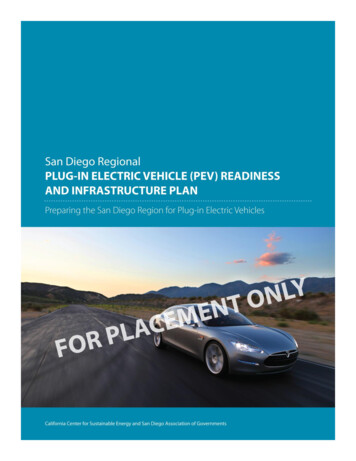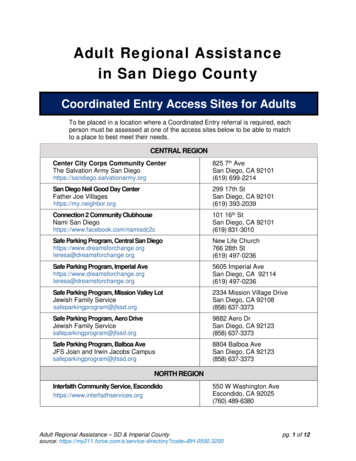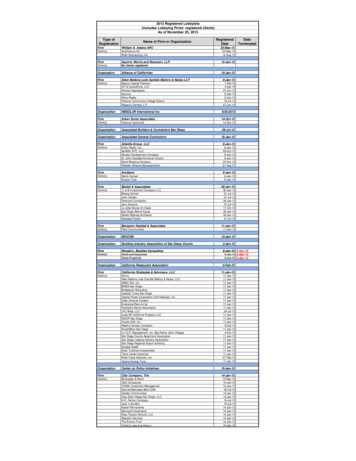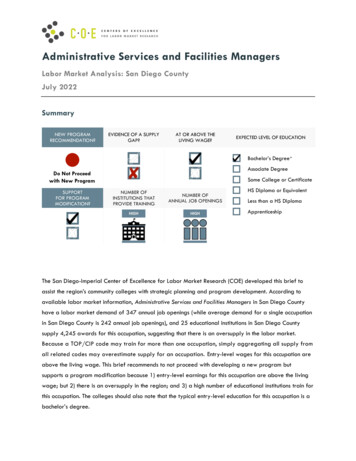
Transcription
1
SAN DIEGO REGIONAL PLUG-IN ELECTRIC VEHICLE (PEV) READINESS PLANThis document was prepared as a result of work sponsored by the California Energy Commission. It doesnot necessarily represent the view of the Energy Commission, its employees, or the State of California.The Commission, the State of California, its employees, contractors, and subcontractors make nowarranty, express or implied, and assume no legal liability for the information in this document; nordoes any party represent that the use of this information will not infringe upon privately owned rights.
SAN DIEGO REGIONAL PLUG-IN ELECTRIC VEHICLE (PEV) READINESS PLANTable of Contents. 1Table of Contents .3Introduction .1Why Use This Plan . 1The San Diego Regional Electric Vehicle Infrastructure (REVI) Working Group and Stakeholders .1Background and Purpose .1Organization and Stakeholder Engagement .1Regional Barriers to PEV Infrastructure . 2PEVs and Public Charging Infrastructure in the San Diego Region .3December 2010February 2012 July 2012 . 4The Basics of Plug-in Electric Vehicles and Charging Infrastructure .5Vehicle Types.5Charging Infrastructure . 6Types of charging equipment . 6Access to public charging infrastructure . 7Finding public charging infrastructure. 7Locations of public charging stations in the San Diego region . 7Regional Plug-in Electric Vehicle Infrastructure Existing Conditions . 8Local Governments . 8Single-Family Residences. 8Multi-Unit Dwellings . 8Workplaces, Retail and Public Locations . 9Regional Planning for Public EVSE Siting . 10Overview . 10Classifying local land use statistics for PEVs . 11Land use/parking analysis for EVSE . 12PEVs in local government fleets . 12Public electric vehicle charging stations . 13Education and Outreach . 13Permitting for EVSE . 13Overview . 13Permitting EVSE installations at single-family residences . 14Charging at multi-unit dwellings . 15Charging at commercial and public sites . 17Charging at the workplace . 17
SAN DIEGO REGIONAL PLUG-IN ELECTRIC VEHICLE (PEV) READINESS PLANZoning and parking policies for PEVs . 18Building code changes . 19Education and Outreach . 20Utility Solutions . 21Overview . 21Utility notification protocol . 21SDG&E Time-of-use rates . 21Minimizing grid impacts . 22Education and Outreach . 23The Road Ahead . 23Overview . 23Increased PEV Presence . 24Estimating the Future Demand for EVSE in the Region . 24
SAN DIEGO REGIONAL PLUG-IN ELECTRIC VEHICLE (PEV) READINESS PLANIntroductionBy the end of 2012, more than 22,000 plug-in electric vehicles (PEVs) were on California’s roads. The SanDiego region has become a leader in the adoption of these vehicles, and accounts for roughly 20% of allCalifornia plug-in electric vehicle ownership. As more San Diegans purchase PEVs, a regional charginginfrastructure network will be necessary for supporting this growing market.The San Diego PEV Readiness Plan (Plan) identifies barriers to the deployment of PEV charginginfrastructure and includes recommendations and resources for overcoming those barriers. This Plan isdesigned for local government officials, such as planners and building staff, as a resource to assist themin helping their local governments prepare for a growing PEV market.Why Use This PlanThe San Diego Regional PEV Readiness Plan provides the following best practices and tools: Insert a table highlighting appropriate best practices and tools by chapter (with corresponding links)and brief description .The San Diego Regional Electric Vehicle Infrastructure (REVI) WorkingGroup and StakeholdersBackground and PurposeIn February of 2012, the San Diego Association of Governments (SANDAG) established the RegionalElectric Vehicle Infrastructure Working Group (REVI) with funding awarded by California EnergyCommission. One of the primary functions of the REVI is to develop a regional readiness plan thatidentifies, reduces and addresses regional barriers to the deployment of private and public PEV charginginfrastructure. The working group builds on previous PEV readiness efforts dating back to 2009.i REVIwas established in March 2012 and continued through December 2013. REVI members discussed andaddressed barriers to PEV infrastructure deployment.Organization and Stakeholder EngagementSan Diego REVI working group members include representatives from local and regional public entities,nonprofit organizations, utilities, universities and community colleges, labor union representatives andcontractor associations, and the business community. All REVI meetings were free and open to thepublic.Each of the 19 jurisdictions in San Diego County was invited to participate as REVI Advisory Member.SANDAG’s six sub-regions were asked to provide one voting member each: North County Coastal, NorthiThe EV Project, funded by the Department of Energy, provided subsidies for public and residential charging equipment andinstallations in the San Diego region. As of September 2013, over 1,400 residential and non-residential charging units had beeninstalled under the project.1
SAN DIEGO REGIONAL PLUG-IN ELECTRIC VEHICLE (PEV) READINESS PLANCounty Inland, East County, South Bay, the City of San Diego and the County of San Diego. A completelist of REVI Members and Advisory Members is available in Appendix A of this document.Regional Barriers to PEV InfrastructureThe REVI identified the following barriers to PEV infrastructure deployment. The barriers identified bythe REVI are included in the table below.BarrierPermitting/InspectionBuilding CodesZoning and Parking RulesTraining and Education forMunicipal Staff and ElectricalContractorsLack of Public Knowledge of PEVand EVSEEVSE at Multi Unit DwellingsRegional Planning for PublicEVSE SitingOn Peak Charging – TOU UtilityRatesPublic Agency EVSE InstallationsCommercial and WorkplaceChargingPEVs in Government FleetsDescriptionLack of streamlined permitting and inspection processes andinconsistent (high) costs across jurisdictions.Lack of standard building codes that accommodate charginginfrastructure or dedicate circuits for charging infrastructure innew construction and major renovations.Lack of standard regional ordinances that facilitate theinstallation and access to publicly available charginginfrastructure.Lack of knowledge about PEVs and EVSE.Municipal outreach to Local Residents and Businesses.Consumer lack of knowledge regarding EVSE installation in thesebuildings. Need to educate and work with HOAs to identify andfind solutions to unique building challenges.Regional land use and transportation plans served as a basis toidentify optimal public EVSE sites.A. Need to discourage charging when electricity supplies are inhigh demand and cost more. Support of time of use (TOU) pricing.B. High demand charges that impact EVSE host utility bills.Expensive metering options to access TOU rates.Contracting issues have stalled many public agencies from takingpart in EVSE installations.Lack of understanding regarding benefits and approaches tounderstanding workplace charging.Procurement justification needed for local public fleets. Need todescribe PEV benefits, including role in reducing municipal GHGsfor Climate Action Plans.2
SAN DIEGO REGIONAL PLUG-IN ELECTRIC VEHICLE (PEV) READINESS PLANPEVs and Public Charging Infrastructure in the San Diego RegionThe following maps illustrate the growth of public charging infrastructure and PEVs in the San Diegoregion from 2011 through 2013.2012 - Public Charging Stations2012 - Public Charging Stations2013 – Public Charging Stations3
SAN DIEGO REGIONAL PLUG-IN ELECTRIC VEHICLE (PEV) READINESS PLANThis graph indicates thegrowth of PEV sales in theSan Diego region. Pleasenote that the spike in 2011is due to the introduction ofan all-electric car sharingfleet, car2go.This graph indicates thegrowth of PEV sales in theSan Diego region. Pleasenote that the spike in 2011is due to the introduction ofan all-electric car sharingfleet, car2go.The chart below shows the number of commercially available vehicles beginning from pre-2011 topresent. Before 2011, there was only one PEV on the market, the Tesla Roadster, now there are over 16PEVs in the market. iCommercially Available Vehicles201020112012201313916December 2010February 2012July 20124
SAN DIEGO REGIONAL PLUG-IN ELECTRIC VEHICLE (PEV) READINESS PLANThe Basics of Plug-in Electric Vehicles and Charging InfrastructureVehicle TypesBattery electric vehicles (BEVs) are fueled entirely by electricity stored in the on-board battery. Thesevehicles are often also referred to as zero-emission vehicles. BEVs typically have a range of 60-120 mileson a single charge.Plug-in hybrid electric vehicles (PHEVs) are fueled by both a battery and another fuel source, usuallygasoline powering an internal combustion engine. These vehicles run on electricity from the on-boardbattery until the battery is exhausted, then switching to an alternate power source. PHEVs typically havea much shorter electric range than fully electric BEVs, and a standard wall outlet may be sufficient forovernight charging.The table below shows the available light-duty PEVs on the market as of September 2013.Battery Electric VehiclesBMW Active EHonda Fit EVChevrolet SparkScion IQ EVCODA SedanTesla Model SFiat 500eMitsubishi i-MiEVFord Focus ElectricNissan LEAFFord/Azure DynamicsSmart fortwo electricTransit Connect Electric drivePlug-in Hybrid VehiclesChevrolet VoltFord C-MAX EnergiFord Fusion EnergiHonda Accord Plug-inToyota Prius Plug-inToyota RAV4 EV5
SAN DIEGO REGIONAL PLUG-IN ELECTRIC VEHICLE (PEV) READINESS PLANCharging InfrastructureThere are three types of vehicle charging available. The table below describes the type of vehiclecharging in relation to the number of miles per hour of charge and where to charge. The time need tocharge a PEV depends on two primary factors, the size of the battery and the size of the onboardcharger. As a rule of thumb, BEVs have a larger battery compared to PHEVs. The onboard charger islocated in the vehicle and determines the amount of power that can enter the vehicle.Type ofVehicleChargingLevel 1(120 volt)Level 2(240 volt)Miles of DrivingRange per Hourof Charge3 to 4DC FastCharger50 to 608 to 20Where toCharge?Standard threepronged outletAt home,workplace, orpublic chargingPublic orcommercial sitesonlyTypes of charging equipmentLevel 1 charging infrastructure consists of a charging cord set providedas standard equipment with every plug-in vehicle (see image to theright of the page). This charging cord can plug into any standard 120volt outlet.Level 2 charging infrastructure is a designated unit that plugsinto or is hardwired into a 208/240 volt circuit. Level 2charging consists of a dedicated charging unit, which is oftenreferred to as electrical vehicle supply equipment (EVSE).Pictured on the left of the page, is an EVSE and below is atable that displays the most common types of Level 2installation styles:Level 2 Installation StyleFloor-mount(Bollard style)Wall/Pole mountInstallation MethodMounted to the ground and wiredthrough the baseInstalled on any wall or pole andcan be wired through a garage wallConsiderationsGenerally requires concrete work alongwith underground trenchingOffers flexible placement options and takesup less floor space than a floor mount6
SAN DIEGO REGIONAL PLUG-IN ELECTRIC VEHICLE (PEV) READINESS PLANThe Electric Drive Transportation Association (EDTA), a U.S. industry association, maintains a website ofover 40 UL-certified EVSE products at arger. EVSEmanufacturers may also provide a contact list of certified contractors for installing charging equipment.Compared to Level 2 infrastructure, the installation of DC fast charging infrastructure is complex andrequires commercial grade electrical capacity. The equipment costs are usually more than 10,000 andinstallations of a single unit can cost up to 50,000.Access to public charging infrastructureMany publically available charging stations require membership cards to access the charging equipment.ChargePoint and Blink are examples of membership networks that require card access.Finding public charging infrastructureDrivers typically utilize websites or mobile applications to locate public charging stations. PEV driverscan find these charging locations by using several online sources including:Charging InfrastructureSourceAlternative Fuels DataCenter Station teDisplays hours ofavailability and number ofcharging units per site.Allows end users to addnew stations.Available online or by amobile application. Userscan leave reviews on publicchargers and have theirown residential chargersdisplayed on the map.Available online or by amobile application.Drivers can filter theirsearch by charger type orbrand. Available online orby a mobile com/searchhttp://www.carstations.comEach branded charging network (i.e., Blink, ChargePoint, eVgo, etc.) has its own application to help itsmembers find network-specific charging locations. Some networks are working together to offer a singlesource of information. One example is Collaboratiev.com, a website being developed to include bothBlink and ChargePoint locations and is scheduled to be released in 2014.Locations of public charging stations in the San Diego regionOver update number before publication public charging sites serve the San Diego region. Insert a map of existing charging locations in the San Diego area, color-coded by PEV adopters withdots indicating where stations are located and clustering of EVSE CVRP 7
SAN DIEGO REGIONAL PLUG-IN ELECTRIC VEHICLE (PEV) READINESS PLANRegional Plug-in Electric Vehicle Infrastructure Existing ConditionsThe San Diego region’s plug-in electric vehicle infrastructure has evolved since 2009. Localgovernments, home owners, multi-unit property managers, and local businesses have all played acritical role in influencing the current PEV landscape.Local GovernmentsLocal governments continue to influence the rate of adoption and infrastructure expansion for PEVs.This influence isn’t always deliberate but in fact, is often unintentional or secondary to other, activities,planning efforts, or regulatory compliance.As regional and local land use planning, design criteria development, and GHG emissions reduction plansare developed, PEVs continue to be integrated into these efforts in a number of different ways. Thisintegration has resulted in building permit streamlining, training for staff, and public charging stations.The San Diego region has worked collaboratively to leverage resources, opportunities, and to betterunderstand and overcoming challenges to institutional and public PEV adoption and EVSE installations.Local governments can influence EVSE installations by continuing to improve and streamline buildingpermit processes and by integrating EVSE installations or pre-wiring for installation into projectconditions or through public charging stations. Public agencies can help disseminate and distributeavailable training and collateral informing staff, contractors, property owners and residents of existingopportunities. As infrastructure becomes increasingly more readily available and permitting time andcosts are reduced, PEV adoption will continue to grow; local governments play a critical role in PEVadoption.Single-Family ResidencesThe EV Project charging behavior data clearly indicated that most PEV drivers charge their vehicles athome. Many PEV drivers with single-family homes will find a standard household outlet (120 VAC)available for charging near where their vehicle will be parked. However, some PEV owners install adedicated Level 2 (240 VAC) EVSE to charge their vehicle. The installation of a Level 2 charger requires apermit from the local jurisdiction and SDG&E notification.Expediting the EVSE permitting and installation process for home owners and approving newconstruction projects with infrastructure already in place, will help to reduce barriers to home chargingand will further PEV adoption. Training and information tailored for home owners is also essential toeasing concerns and informing PEV drivers.Multi-Unit DwellingsMulti-unit dwellings, or MUDs, continue to present barriers to PEV drivers. As noted above, most driverscharge their PEVs at home; however MUDs offer a unique set of challenges. Shared utilities, parkingdesignations or restrictions, as well as design and infrastructure hurdles, make EVSE installations morecomplex.8
SAN DIEGO REGIONAL PLUG-IN ELECTRIC VEHICLE (PEV) READINESS PLANSDG&E has worked with local property managers and MUD PEV drivers to establish best practices, offerworkshops, and to develop case studies of local MUD EVSE installations.?MUD EVSE installations will continue to be a challenge for all of the reasons already listed, but withcontinued work by SDG&E and by integrating EVSE into permitting and planning processes and languagethis process will become more streamlined. As EVSE installations become easier, PEV adoption ratesamong MUD residents should increase.Workplaces, Retail and Public LocationsPEV drivers can be limited to the range of their vehicle. Although most veteran PEV drivers are aware ofthe range of their vehicle, others are plagued with range anxiety which can stifle one’s use of or evendecision to purchase a PEV. A number of local retailers, workplaces and public destinations now haveEVSE available to their customers, employees and the public. Expanding charging options for PEV driverswill continue to play a critical role in broadening the range and number of PEV adopters.EVSE installations at workplace, retail, and public locations will continue to expand the existing chargingnetwork and will give PEV drivers options similar to those available to traditional vehicles. Localgovernments, SDG&E, contractors, business and property owners continue to work together to addressinstallation barriers. Contractor and business owner training, education, and outreach continue to becrucial to making the business decision for EVSE. The permitting processes and construction andelectricity costs also are concerns for local business owners and can hinder EVSE installations. Localgovernments can also provide infrastructure on public property as a means to lead by example (foremployees and customers) and to help fill gaps in the charging network.Regional Barriers to EVSE Deployment & Key RecommendationsThrough earlier PEV planning and siting efforts (i.e., EV Project) several barriers had already beenidentified as obstacles to regional charging infrastructure installation and PEV adoption (see RegionalBarriers to PEV Infrastructure section above). The REVI defined these and discussed new or expandingbarriers to PEV deployment and grouped the eleven barriers into three priorities categorizingcomplementary or parallel efforts together. The flow chart on the following page illustrates theprioritization of the barriers. This section defines the priority categories and the activities, resourcesand outstanding hurdles to addressing each of the barriers.9
SAN DIEGO REGIONAL PLUG-IN ELECTRIC VEHICLE (PEV) READINESS PLANRegional Planning for Public EVSE SitingOverviewThe EV Project established a stakeholder working group for regional collaboration and prioritization forpublic charging planning and siting. This was the first regional planning effort to establish priorities forinstallation of PEV charging infrastructure. Together, the EV Project Stakeholder Advisory Committee(ESAC) was able to produce infrastructure siting maps that guiding the EV Project efforts in placement ofpublic charging stations (Regional Planning for Public Charging in San Diego fact sheet is included inAppendix B).The REVI has built upon the regional planning efforts initiated by the EV Project and identifiedchallenges, successes and outstanding issues for continued PEV adoption and EVSE deployment.Collaborative planning for regional charging infrastructure is necessary to establishing a cohesive andinterconnected charging network. Assessing priority siting locations, establishing optimal land use,access, and understanding driving behaviors isn’t limited to the boundaries of a single city or publicagency. Defining the needs and establishing ideal locations to support EVSE and benefit PEV drivers hasto be done on a larger scale to be effective and functional.The Electric Power Research Institute (EPRI) pyramid below illustrates charging priorities for PEV driversand aligns with regional sitting to date. The base of the pyramid shows that PEV drivers primarily chargeat home; this is the most reliable, comfortable, and cost effective option. The region has seen the mostinfrastructure installed residential locations.10
SAN DIEGO REGIONAL PLUG-IN ELECTRIC VEHICLE (PEV) READINESS PLANSecondary to home, work is the most commondriving destination. Workplace charging offersPEV drivers a reliable charging option during thework week at a location already part of theirdaily routine; charging at work won’t add newstops or change existing travel patterns andallows for more charging options. The REVI hasrecognized the challenges and barriersassociated with workplace and retail charging asa result of the EV Project and continue to try andfacilitate more EVSE opportunities through newor innovative possibilities; often using local orstatewide examples and resources.Lastly and most necessary for continued PEVadoption, is public charging. Public charging makes up the smallest portion and sits at the top of thepyramid. Public charging represents the least available charging option for PEV drivers. Public chargingstations offer PEV drivers the same conveniences that traditional gas vehicles drivers have. Making EVSEpublically available in more locations also helps to reduce range anxiety and makes transitioning to PEVseasier. Public charging is faced with the most barriers to both PEV adoption and regional planning andinstallations. Working together with other local public agencies has expanded the resources andexperience available to address regional EVSE availability.Classifying local land use statistics for PEVsUnderstanding local land uses and driving habits helps to identify optimal locations for charging stationsand appropriate type of charging equipment (EVSE). The following table describes the different chargingequipment, and the type of venue or destination a PEV driver would use the charging stations.EVSELevel 1(EVSE)User ProfileTypical VenuesCharging TimeMiles/1 Hr ChrgStreet/Meters1-2 hoursParking Garages2-10 hoursParked for 6Cultural/ Sports Centers2-5 hours3-48 hoursAirport (long-term)8-72 hoursHotels/Recreation Sites8-72 hoursLevel 2Parked for 2Shopping Centers0.5-2 hours(EVSE)4 hoursAirport (short-term) 1 hourStreet/Meters1-2 hoursParking Garages2-10 hours8-20 (dependingCultural/ Sports Centers2-5 hourson vehicle onAirport (long-term)8-72 hoursboard charger)Hotels/Recreation Sites8-72 hoursInterstate Highways 0.5 hoursCommuting/Recreation Roads 0.5 hoursDC FastQuick stopShopping Centers0.5-2 hoursChargefor 5-30Airport (short-term) 1 hour50-60(DCFC)minutesInterstate Highways 0.5 hoursCommuting/Recreation Roads 0.5 hoursAdopted from the Bay Area and Monterey Bay Area—Plug-In Electric Vehicle Readiness Plan (p. 24)11
SAN DIEGO REGIONAL PLUG-IN ELECTRIC VEHICLE (PEV) READINESS P
San Diego region. Please note that the spike in 2011 is due to the introduction of an all-electric car sharing fleet, car2go. This graph indicates the growth of PEV sales in the San Diego region. Please note that the spike in 2011 is due to the introduction of an all-electric car sharing fleet, car2go.










